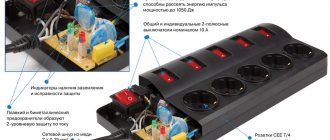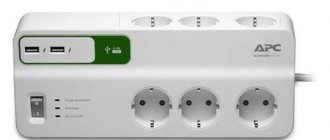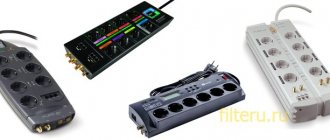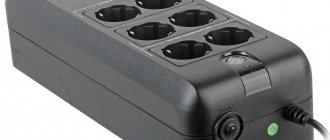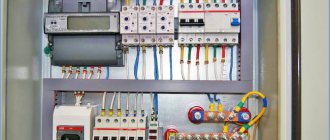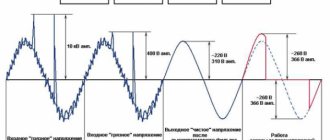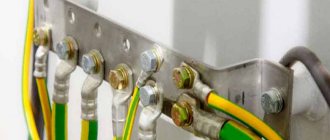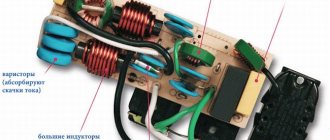Many people believe that a surge protector for a computer is an ordinary extension cord with a large number of outlets, usually 4 or more. This is wrong.
In fact, a surge filter is a device that is designed to protect a computer from pulsed and high-frequency interference in a 220V electrical network. Therefore, to the question: “Do you need a surge protector for your computer?” You can answer without hesitation: “Yes, we need it.”
The article turned out to be voluminous, because it was necessary to consider the following points:
- Introduction: how can you understand without it why this is and why this is so?
- Surge filter device
- With slow voltage drops
- Anti-interference
- Technical features of the surge protector
- How to choose a surge protector for your computer?
- You need to know this!
- Information only for laptop owners
Surge filter: what is it for?
The outlet in the home network has an AC voltage of 220 V. Current and voltage periodically change magnitude and direction.
A sinusoidal EMF is generated at the output terminals. Since electrical devices are capacitive in nature, electromagnetic interference occurs. Due to interference, an unevenly shaped sine wave enters the sockets, so household appliances will also operate with interference. The filter helps reduce interference to clean device power and remove radio interference from devices.
Consists of a noise filter, a button, a varistor, a socket group and a power cord. They are available equipped with various sensors, USB and other components.
Causes of extension cord failure and how to detect them
Such specimens have fragile wires that are easily susceptible to mechanical stress.
Conventionally, an extension cord consists of three parts - a housing with sockets, an electrical cord and a plug. There are two types of devices available for sale:
- With the simplest design. Such extension cords supply current to electrical appliances using two wires - zero and phase, and do not have a switch button.
- Models with additional parts that have a power button; the cable can be two- or three-wire (zero, phase and ground).
Inside the main block there are two current-carrying busbars (yellow metal plates that are inserted into the grooves of the housing). Their rounded areas are aligned with the socket connectors.
The three-phase extension cord has an additional grounding bus.
The reasons for device failure may be different. Most often, they are associated with mechanical stress and violation of operating rules.
In other words, over time, the wire breaks and breaks. Mechanical failures occur when the cord is squeezed, bent at an acute angle, or pulled sharply. This also includes deformation of the tires when the consumer device is repeatedly turned on and removed from the socket.
What are there
The following types exist:
- basic - these are inexpensive devices that are used for small household appliances;
- advanced – used for any home appliances;
- professional - used for expensive home appliances that are sensitive to voltage changes. Purchased for home theaters and expensive stereo systems.
The higher the quality of the filter, the more reliable it works.
For stable operation, it is connected to a grounded outlet. In the absence of grounding, operating efficiency is reduced by 20-40%.
Base
Basic (Essential) are purchased for inexpensive household appliances - table lamps, watches. They are characterized by low cost and ease of use. Such devices are designed to suppress voltage surges up to 960 Joules. Despite the small operating range, they also reliably perform work to protect home appliances.
Advanced universal with lids
The most used ones are advanced (home, office) devices with covers.
Suitable for protecting home equipment - computers, washing machines, TVs. Dissipate 900 – 2000 J depending on the model. They are considered universal in terms of price-quality ratio, therefore they are used more often than other types.
Professional with protection
Professional (Performance) - dissipates over 2000 J. Used when working with complex equipment that is sensitive to voltage changes - for example, expensive speaker systems, home theaters. The price of such devices is much higher.
Smart controlled
Managed ones are allocated to a separate category from the “smart home” system. Radio-controlled surge protectors have been around for many years; modern modifications with Bluetooth or WLAN are more convenient for use. You can control such a device using your phone or tablet even while away from home. Thanks to such devices, you can control the operation of home equipment, even while away from home.
Tools and materials
Before connecting an outlet with a single-key switch (and grounding), you need to prepare a simple set of tools and materials. The kit includes:
- at least three screwdrivers: indicator, flat and Phillips;
- electric drill and drill bit;
- four-wire cable;
- knife with a thin blade;
- mounting box;
- side cutters (nippers);
- pliers;
- insulating tape.
All tool handles must be securely insulated.
Filter device
The design contains 2 mandatory working elements - a varistor to normalize voltage and an LC filter to smooth out interference. The device also contains other elements that extend the service life of the device and increase efficiency.
Interference filter
The design (LC) consists of a neutral and phase wire, which are connected to an inductor. There are one or more capacitors between the wires. Typical ratings of coils are 50-200 microhenry, capacitors are 0.22-1 microfarad. Necessary for smoothing out impulse noise, which negatively affects the operation of devices. The LC filter "absorbs" this noise, making the signal smoother and more even.
Tumblr
Used to avoid unnecessarily pulling the plug out of the socket. The toggle switch reduces wear on the contact plates of sockets, increasing their service life. This is an optional part.
Varistor
A semiconductor component with a nonlinear current-voltage characteristic is a varistor.
When a certain voltage value is reached, it protects the load by briefly closing the circuits. Helps protect equipment from “bad” voltage. A varistor with a rating of 470 Volts is used as standard.
Rosette group
A socket group is a set of sockets for connecting devices to them. There are filters for 1, 2, 3 or more home appliances.
When connecting several devices to a surge protector, you need to focus not on the number of sockets, but on the total power of the equipment. Excessive load may result in overheating and fire.
Cord
Any filter is equipped with a protective cord through which it is connected to the network. The cord has an insulating coating and protects the wires inside. When purchasing, take filters with a suitable cord length.
Other scheme options
In this case, the distribution box will receive two wires from two output contacts of the switch and two phase conductors from the lamps. The same as in the example described above, only there will be one more twist in the box. If you need to install a three-key switch and three groups of lamps, then three wires from the three output contacts of the switch and three phase conductors from the lighting devices will arrive in the distribution box. There will be 5 twists in total in the box:
- Zero supply network with zero wires of the socket and lamp.
- Power supply phase with phase conductors of socket and switch.
- And three twists of phase wires extending from each switch key and group of lamps.
In the case of protective grounding, another twist will be added. Sometimes it can be quite problematic to arrange twisted wires in a junction box. Now on the electrical goods market you can select options specifically designed to accommodate a large number of wires and cables.
This is how you can easily connect a socket and a switch from one junction box. The main thing is to try to understand this very simple scheme. And then all further electrical circuits will be clear to you. As a result, you will get quite a decent cost savings on calling a professional electrician.
The best filters for household appliances
It is worth choosing a filter for home appliances, taking into account various factors.
First of all, you need to know in advance what devices it will be connected to. Small household appliances and powerful devices cannot be protected by a single type of filter. You should also choose devices from reputable manufacturers. When purchasing, you need to pay attention to the markings - for example, the CE mark indicates that this device is proven and of high quality.
How to choose for a refrigerator
Main selection criteria:
- power that the filter can withstand;
- number and type of sockets;
- presence of grounding contacts;
- design features;
- length of cable;
- device appearance and design.
Load is the most important selection parameter. Before purchasing, carefully study the passport of the refrigerator, and only then buy the device.
How to choose for TV
The TV device guarantees uninterrupted operation without interference and surge voltages.
For inexpensive TVs, it will be enough to purchase a 250 V filter. For LCD TVs, you can additionally install stabilizers matched to the outlet voltage.
For uninterruptible power supply
You can connect a UPS (uninterruptible power supply) through a surge protector. It will reduce the load on the uninterruptible power supply.
The surge protector should not be placed between the UPS and the load, as the battery will discharge faster in this case.
Why do you need a surge protector with grounding for a washing machine?
The surge protector for a washing machine is designed in such a way that it suppresses any frequencies other than 50 Hz. A large power surge can damage your washing machine. Excess currents that may arise are discharged to grounding. The washing machine, like other powerful equipment, must be connected separately.
What is a master socket
Filter master socket
Let's look at the question - a surge protector with a master socket, how it works, and whether this function is needed. This is an additional option for surge protectors that have multiple outlets. In such devices, one connector is designated as the senior one (Master), and all the others are assigned as auxiliary connectors (Slave). Typically, the system unit of the machine is connected to the senior connector, and other peripherals are connected to the rest: monitor, modem, printer, audio system, etc.
The filter electronics monitor whether there is electricity consumption at the Master connector; if there is none, then all the others are turned off. This is a very useful feature that allows you to save a lot of energy.
It is also convenient for the user to use such a filter - there is no need to press the power keys of all devices upon completion of work. Completely turned off devices consume no energy at all, unlike standby mode, and are more fireproof.
This filter is convenient not only for the computer. In addition to this, there may be several other systems in the house, the operation of which is dependent on the main device, for example: a TV, a DVD or Blue-Ray player, a satellite receiver, a home theater.
Without TV, the rest are useless. True, after applying voltage, many of the systems will have to be transferred from standby mode to operating mode manually. But, in most cases, modern technology easily communicates through other channels and turns on independently.
Is it possible to assemble a surge protector yourself?
One of the homemade products
If you are well versed, not even in radio engineering, but simply in electrical engineering, then making a simple filter with your own hands will not be difficult. The circuit (and there are plenty of them on the Internet) is no more complicated than for the reversible connection of a three-phase motor. By the way, we cited one of them above. Here's another option.
Homemade filter circuit
All its components can be easily purchased in specialized stores. Installation can even be done “canopy”, without a printed circuit board (do not forget about reliable fixation of all parts and electrical safety requirements).
It is not necessary to buy parts for such a filter - capacitors and resistors can be removed from failed equipment. The choke is more difficult to find, but you can wind it yourself. The problem can only arise with a varistor, although the price of this semiconductor device is low.
When using parts from decommissioned equipment, pay attention to the operating voltage of the capacitors - it should be at least 400 volts (preferably more, despite the fact that our network has 220). This will ensure reliable operation during power surges.
Important: Polarized electrolytic capacitors cannot be used for the AC filter. Please note that the connection polarity (“-” or “+”) is not indicated on the device body.
The best and most reliable filters for your computer
Computers and laptops need protection from power surges and interference. For stable operation, it is important to choose the right filter. There are devices with and without grounding. You should also purchase an uninterruptible power supply for your computer, which will allow you to save data on your PC during a sudden power outage.
With grounding: operating principle
Grounding is the main condition for the safety of the device. In case of overheating or short circuit, the device dumps excess voltage or current to grounding, which protects the device from breakdown or fire.
Without grounding: what does it protect against?
Suppresses short-term impulse noise thanks to the semiconductor element. To suppress network noise, the design contains inductors. There is a special fuse to protect against short circuits.
Built-in wall
In-wall appliances are used in homes with a three-wire network. Popular models of this type of device are Mosaic 45 from Legrand.
How does automatic shutdown work?
Models with automatic shutdown react to excess current/voltage in the network. They turn off the power supply to devices, protecting against fire and damage. Automatic units do not require constant replacement and have a longer service life. To restore operation after a power surge, just press the button on the filter. Such devices are more expensive than classic ones.
Installation features
block
It will not be difficult to install a combined unit without the involvement of a professional electrician, since connecting modern models requires a minimum of wires.
The installation process will have only a few features that need to be taken into account:
- You need to prepare the necessary tools in advance ; you won’t need many of them: an electric drill with a drill core; several screwdrivers of different sizes; pliers and wire cutters.
- To ensure safety during work , make sure that the handles of all tools are insulated.
- Some modern varieties are designed for external installation, that is, when installing them, you can completely avoid drilling holes in the wall surface.
- You can choose a variety with an increased level of protection from environmental conditions ; such models can be installed not only indoors, but also outdoors. Such devices also have an additional element in the design in the form of a special lid that helps prevent liquid from getting inside the device.
- All modern types of blocks are suitable for installation in walls made of any material and regardless of the type of finish.
How to connect a regular and built-in filter
A surge protector is often confused with a classic extension cord. The only common characteristics they have is their appearance. Their operating principle is different. The main task is to absorb voltage surges.
The connection is similar to turning on the adapter. Plug it into the socket, then connect the necessary household appliances to it. After the household appliances are connected, turn on the button on the housing. When used for more than seven days, it should be unplugged from the outlet during breaks.
Each model has its own maximum power rating for which it is designed. Therefore, it is important to ensure that the total load of connected devices does not exceed this value, otherwise the device will fail.
When working, you must follow the safety rules:
- You cannot connect several filters to each other;
- if a computer is connected to the filter, then you cannot connect fans, air conditioners and other powerful equipment to it;
- For equipment with high power, you should buy a separate filter.
Correct connection of the switch. At what height should the light switch be placed?
Before connecting the switch, you need to establish the level at which it will be located.
Sockets and switches can be installed at any height. During the Soviet period, sockets were located at table level, and switches were located quite high. Now the sockets are placed low. This is due to the large number of constantly connected devices and the reluctance to pass bundles of wires in plain sight. Switches also began to be mounted much lower, at a distance of about 1 m from the floor. Typically, this is to ensure that turning lights on and off in rooms is easy for short people. You can install the switch in the most convenient place for you.
Which is better - a stabilizer or a surge protector?
A surge protector and a voltage stabilizer perform similar functions.
The first smoothes out the impulses, and the second maintains the voltage at a normal level. It is preferable to choose a stabilizer, since it protects equipment at several levels. When triggered by undervoltage or overvoltage, the surge protector will have to be replaced, as the fuse in it will blow. The stabilizer, in turn, gently disconnects the power from the network; if necessary, it can be connected again.
The power reserve for both types of protective devices is the same, approximately 20-30%. The price category is also similar; for the same price you can buy both a high-quality surge protector and a reliable voltage stabilizer.
A voltage stabilizer cannot be replaced with a filter if the network is unstable and with voltage surges. It is also better to buy a stabilizer when expensive household appliances are installed in the house.
When purchasing valuable electronics for your home, you need to consider the issue of security. A surge protector is a protective device that helps protect home appliances from voltage surges and surge noise. There are different types and different purposes, so you need to buy your own device for a certain type of equipment. The right choice will ensure reliable power supply to home appliances for many years.
Correct understanding of the functions of the extension cord
This derivative word from the verb “extend”, which is used to name such a product often used in everyday life, can be interpreted in two ways - the network to the consumer is extended, or the power cord of the electrical appliance becomes longer.
A correct understanding of the functions of an extension cord lays the foundations for fire safety when connecting various consumers to portable sockets.
In news reports about various incidents, we very often heard that such and such an office burned down due to the fire of an extension cord overloaded with computers, printers and other office equipment.
Extension cord manufacturing process
To assemble, you will need a sharp stripping knife, pliers, and a set of screwdrivers. After the preparatory work, you can begin the actual production of the extension cord.
We recommend starting assembly with the fork. To do this, remove the top insulation by 5-6 cm. After this, we clear the cores themselves of approximately 1 cm of insulation. We disassemble the plug and attach the bare wires directly to the plug.
The main point is not to confuse the grounding wire. The location of the phase and zero does not matter. After this, you should reassemble the plug in reverse order.
After this, you can begin installing the sockets on the extension cord. The housing is disassembled and the wires are attached inside the block. We pay special attention to grounding. After fixing the wires in the block, you should assemble the socket housing.
After final assembly of the entire extension cord, we recommend checking it with a multimeter. After checking, the work on manufacturing the extension cord can be considered completed.
If you plan to make a very long extension cord, we can recommend using a reel. In this case, using this extension cord will be most convenient.
You can use a certain amount of extension cord without the fear of getting tangled in an unnecessary part of the extension cord. Storing an extension cord on a reel is much more convenient than in a coil.
Source: electrikexpert.ru
Preparing to assemble the extension cord
Before making an extension cord, you first need to decide on its purpose. This will allow you to determine the possibility of connecting certain devices, as well as the maximum permissible power. These factors have a direct impact on the choice of cable cross-section and other components. It is recommended to select all parameters with a small margin, so that in the future there is the possibility of connecting more powerful electrical equipment.
First of all, you need to buy a wire that will be used as a cord. The best option is considered to be PVS copper wire, which is characterized by increased flexibility. If there is a grounding contact in the socket, the wire must be three-core, but if it is absent, a cable with two cores can be used. When purchasing, you should carefully study the product labeling.
If the brand “PVA 3 x 1.5” is indicated, this means that the wire is three-core and the core cross-section is 1.5 mm. These parameters allow you to connect a load with a power of up to 3.5 kW. For a power of 5 kW, a cross-section of 2.5 mm will be required. The data for calculations can be taken in a special table, which will significantly speed up the solution to the question of how to make an extension cord with your own hands.
How to make an extension cord with your own hands
In everyday life, situations quite often arise when the available sockets in an apartment or private house do not allow the use of any electrical appliances or household appliances. The main reason is their inconvenient location, so owners prefer to use an extension cord. In some cases, increased power outlets or a longer cord are required. In this case, home craftsmen make an extension cord with their own hands. A self-made extension cord will be much cheaper. If you have the skills to work with the tool, the entire procedure takes from 15 minutes to half an hour.
How to assemble an electrical extension cord with your own hands
At the first stage, the top insulating layer is removed from both sides of the cable by approximately 5-7 cm, after which the ends of each core are stripped to 1 cm. Next, the plug is disassembled by unscrewing the fastening bolt. After this, you need to loosen the screws on the clamp that secures the cable inside the plug body. Then the stripped wires are connected to the two plug contacts.
The location of the conductors does not matter; the most important thing is to correctly connect the grounding contacts on sockets and plugs. After connecting the conductors, the plug is reassembled.
At the final stage, the socket block is disassembled and two conductor cores are connected to the contacts. The third wire is connected to the ground pin, exactly the same as on the plug. Thus, both ground contacts are connected by a single wire.
If the core consists of many wires, then it is recommended to solder it or fix it with a tip. As a last resort, you can simply twist the wires using pliers. After all connections, the cable is fixed inside the housing and the final assembly of the unit is performed. The finished extension cord is checked by plugging it into a home electrical outlet or using a multimeter.
Preparatory work
Before you start making an extension cord, you should decide in what conditions it will be used. Don’t forget the power of connected devices.
After all, it depends on this which cable you should buy to make an extension cord.
Once you have decided on the desired requirements, you should prepare a list in which you indicate which components you need to assemble a high-quality extension cord.

